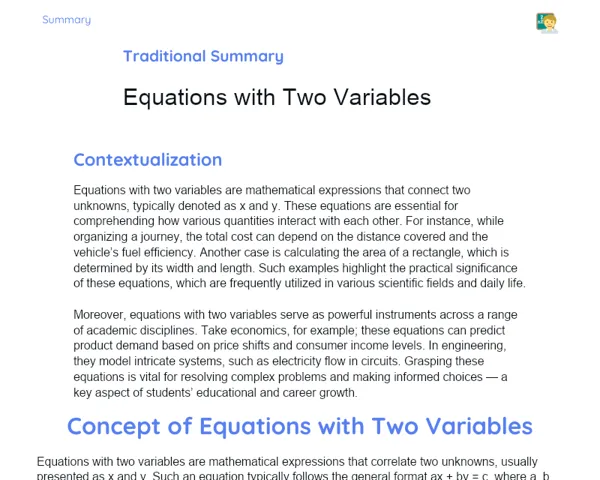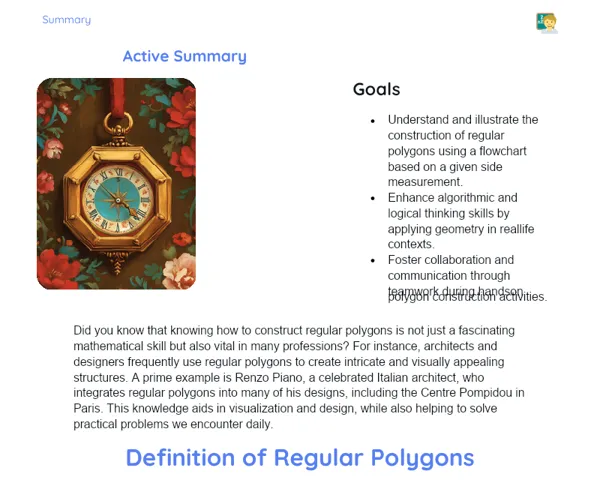Summary Tradisional | Matrix: Equality
Contextualization
Matrices are essentially arranged in rows and columns, forming a neat rectangular array of numbers. They are widely used in various fields, including engineering, physics, economics, and computer graphics. For instance, in computer graphics, matrices help us perform tasks like rotations and scaling, which are key when modelling 3D objects.
The concept of matrix equality is quite important. Two matrices are said to be equal only when they share the same dimensions and every corresponding element is exactly the same. This idea is not only useful while solving linear equations but also very practical when comparing data in areas such as search algorithms and other computational fields.
To Remember!
Definition of Matrix Equality
In linear algebra, establishing whether two matrices are equal is a fundamental concept. Simply put, two matrices A and B are equal if they have identical dimensions, and each element in row i and column j of matrix A matches the corresponding element in matrix B. In mathematical terms, we express this as A = B if, and only if, a_ij = b_ij for all valid indices i and j.
This idea is very practical; for example, when solving systems of linear equations, we often need to verify that two matrices are equal to confirm that the solutions are correct. This concept also extends to real-world applications in fields such as economics, engineering, and computer science, where ensuring the accuracy of data is crucial.
-
Both matrices need to have the same dimensions.
-
Every corresponding element in the matrices must match exactly.
-
We denote A = B if, and only if, a_ij = b_ij for all values of i and j.
Identification of Elements and Unknowns
Matrix equality can be an effective tool to determine unknown elements. When two matrices are equal and one of them contains unknown values, we can equate the corresponding elements to solve for these unknowns. For instance, if we have matrices A = [[x, 2], [3, y]] and B = [[1, 2], [3, 4]], then by setting the corresponding elements equal, we deduce that x = 1 and y = 4.
This method is routinely used in both classroom exercises and practical scenarios, such as solving linear equation systems or validating mathematical models in various fields.
-
Matrix equality helps in identifying unknown elements.
-
Equate the corresponding positions in the matrices to solve for these values.
-
This approach is useful in both solving linear equations and in mathematical modelling.
Properties of Matrix Equality
Matrix equality is underpinned by a few key properties: reflexivity, symmetry, and transitivity. Reflexivity means that every matrix is equal to itself, i.e., A = A. Symmetry implies that if matrix A equals matrix B, then matrix B equals matrix A. Transitivity means that if A equals B and B equals C, then A must equal C. These properties are essential for logical reasoning and the manipulation and comparison of matrices.
-
Reflexivity: A = A.
-
Symmetry: If A = B, then B = A.
-
Transitivity: If A = B and B = C, then A = C.
Practical Applications of Matrix Equality
Matrix equality finds applications in numerous practical scenarios. For example, in computer graphics, matrices are pivotal in transforming coordinates and modifying images. Checking for matrix equality helps ensure these transformations are consistent and accurate.
In the realm of search algorithms, matrices assist in organizing and classifying data. Ensuring their equality is a useful way to verify that the data is consistent and reliable. Additionally, solving systems of linear equations—a common task in many scientific and engineering applications—relies on matrix equality to validate solutions.
-
In computer graphics, matrix equality ensures consistent transformations.
-
It is used in search algorithms to validate data consistency.
-
When solving linear equations, it helps in confirming the accuracy of the solutions.
Key Terms
-
Matrix Equality: Two matrices are considered equal if they have the same dimensions and every corresponding element is identical.
-
Corresponding Elements: Elements located in the same position in two matrices considered equal.
-
Unknowns in Matrices: Variables or values that can be determined by equating corresponding elements of equal matrices.
-
Equality Properties: The fundamental properties—reflexivity, symmetry, and transitivity—that define matrix equality.
Important Conclusions
In this lesson, we delved into the vital concept of matrix equality, which is integral to both mathematics and its practical applications. We learned that two matrices are alike only when they have the same dimensions and every corresponding element matches perfectly. We also explored how to use this equality to find unknown elements, along with understanding the key properties of reflexivity, symmetry, and transitivity.
Understanding matrix equality is essential for solving complex issues like systems of linear equations, which are frequently encountered in fields like engineering and economics. It also plays a significant role in ensuring the accuracy of processes in search algorithms and computer graphics. This knowledge not only sharpens our mathematical skills but also prepares us for various challenges in both academic and professional contexts.
We encourage everyone to explore further and practice these concepts to fully appreciate how matrices underpin many everyday computational and engineering problems.
Study Tips
-
Go through the examples discussed and try to solve more problems on your own to strengthen your grasp on matrix equality.
-
Review and practice the properties of reflexivity, symmetry, and transitivity through practical exercises.
-
Investigate real-life applications, like those in computer graphics and search algorithms, to see the relevance of matrix equality.



